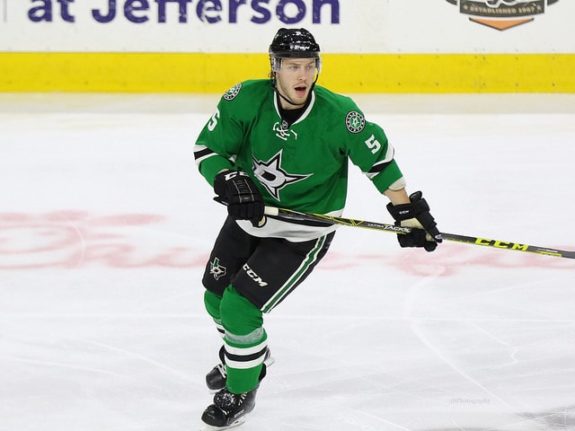Defenseman Jamie Oleksiak has developed into one of the most valuable pieces within the Dallas Stars organization. Appearing in every regular-season and postseason game for Victory Green, including two game-winning goals in the Stanley Cup Playoffs, 2019-20 was nothing short of a breakout campaign for the former first-round pick in 2011.
So much so, aside from the fact that he was once traded away and re-acquired by the Stars — he’s been recently trusted to anchor the opposite side of young sensation Miro Heiskanen, who led all NHL defensemen in points for the 2020 Playoffs just a short time ago.

The timing couldn’t be better for the 27-year-old, as he’s set to become an unrestricted free agent next summer and figures to gain substantial interest as it is. However, taking yet another step forward in his development could make him among the top priorities in the open market, with a hefty raise to the current $2.1 million average annual value all but certain.
Unfortunately, a valuable NHLer doesn’t always lead to success for fantasy hockey managers. It’s safe to say a player with 18 goals across 313 regular-season games won’t be made a priority on many draft boards this winter. With that said, hopefully by now your league manager has expanded categories or point-scoring opportunities that benefit defensemen, as it does nothing but expand the league’s player pool and increases opportunity for real-life value.
The “Big Rig” is fully cemented as a top-four defenseman in Dallas — and perhaps, the prime beneficiary of one of the more favorable situations in the game today. Oleksiak’s physical track record and increase of ice time has ascended the potential for fantasy relevance, with plenty of upside to gain playing alongside Heiskanen and a speedy offensive attack.
Category Filler
The Ontario native has ranked within the top-15 among defensemen in hits for two of the last three NHL seasons, reaching as many as 174 in 2018. After collecting 153 in 69 regular-season games, the 117 hits recorded in the playoffs led all NHL defensemen, trailing only Tampa Bay Lightning forward Blake Coleman for the league lead.

Oleksiak’s 6-foot-7, 255-pound frame has also developed into an exceptional shot-blocker. Finishing third in the NHL in postseason blocked shots (65), he recorded 25 blocks in the final six games. The trend figures to continue, as he tacked on at least 45 seconds of shorthanded ice time in 23 of the Stars’ final 27 games, including six where he exceeded well over three minutes on the kill.
While he’s seen increased shorthanded time, he’s also been the culprit of putting the Stars on the job. If your league awarded penalty minutes (PIM) in 2019-20, Oleksiak contributed to a team-leading 41 PIM, including three fighting majors.
Offense By Association
The increased minutes for Oleksiak are a culmination of personal development across eight NHL seasons, but also, the chemistry recently established with the 21-year-old Heiskanen, a player who appears to be well on his way to a breakout campaign as the Stars’ top offensive defenseman.
The duo provides a unique balance of size, speed, skill and physicality on the Stars’ active back end and are expected to be partnered up again for full-time duties in 2020-21. It’s difficult to imagine they’d totally surpass Esa Lindell and John Klingberg, but both pairings will see well over 20 minutes of ice time per game, contributing across all situations.

Oleksiak is most naturally suited to protecting the front of the net (and everybody in a Stars uniform), but the trust from the coaching staff to showcase his ability to fly under the radar in the offensive zone has appeared to have elevated.
Postseason Emergence
Beginning Round 1 with over 24 minutes of ice time, he recorded an assist on the Stars’ first goal of the series against the Calgary Flames. The play began with Oleksiak cycling the puck behind the net and dishing to Heiskanen, who found forward Denis Gurianov for the goal.
As if that wasn’t already a dream scenario for Oleksiak’s offensive upside, arguably the biggest goal of his career would come immediately following in Game 2, beating goaltender Cam Talbot with roughly 39 seconds remaining in regulation to prevent the Stars from a two-game series deficit.
However, this goal was by no means a typical “close your eyes and shoot” situation from the blue line. After getting the green light to join the offensive rush yet again, Oleksiak found separation and finished the play from nearly the top of the crease, thanks to a perfect feed from Corey Perry. The points scored in back-to-back games against the Flames marked the first time Oleksiak had been on the scoresheet in consecutive postseason games, but it wouldn’t be the last.
He went on to execute close to the same result in the very next round against the Colorado Avalanche, contributing an assist in Game 1, followed by a goal in Game 2. However, none could be sweeter than the Stars’ opening tally in Game 3 of the Western Conference Final against the Vegas Golden Knights, where he blocked a shot, then fled up the neutral zone on the way to a breakaway goal in highlight-reel fashion.
After lighting the lamp in every series this postseason, Oleksiak ended the playoffs averaging over 21 minutes of ice time and recording nine points, a career-high scoring rate across 27 games. His final goal — the Stars’ second in Game 2 of the Stanley Cup Final — proved to be another game-winner, etching his postseason performance among the most impressive on the club.
While this particular scoring clip remains highly unlikely, obtaining top-four responsibilities, along with a serviceable supporting cast, adds significant intrigue to a player who is already becoming a bona fide category filler. Oleksiak should warrant plenty of consideration in deeper leagues that award hits, blocked shots, and PIM — with plenty of opportunity to continue contributing offensively as well.